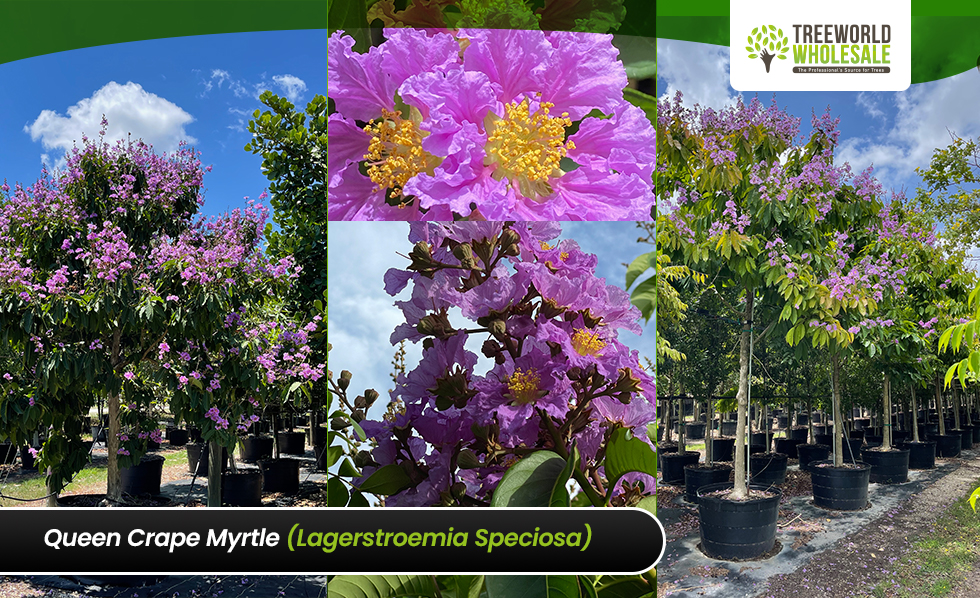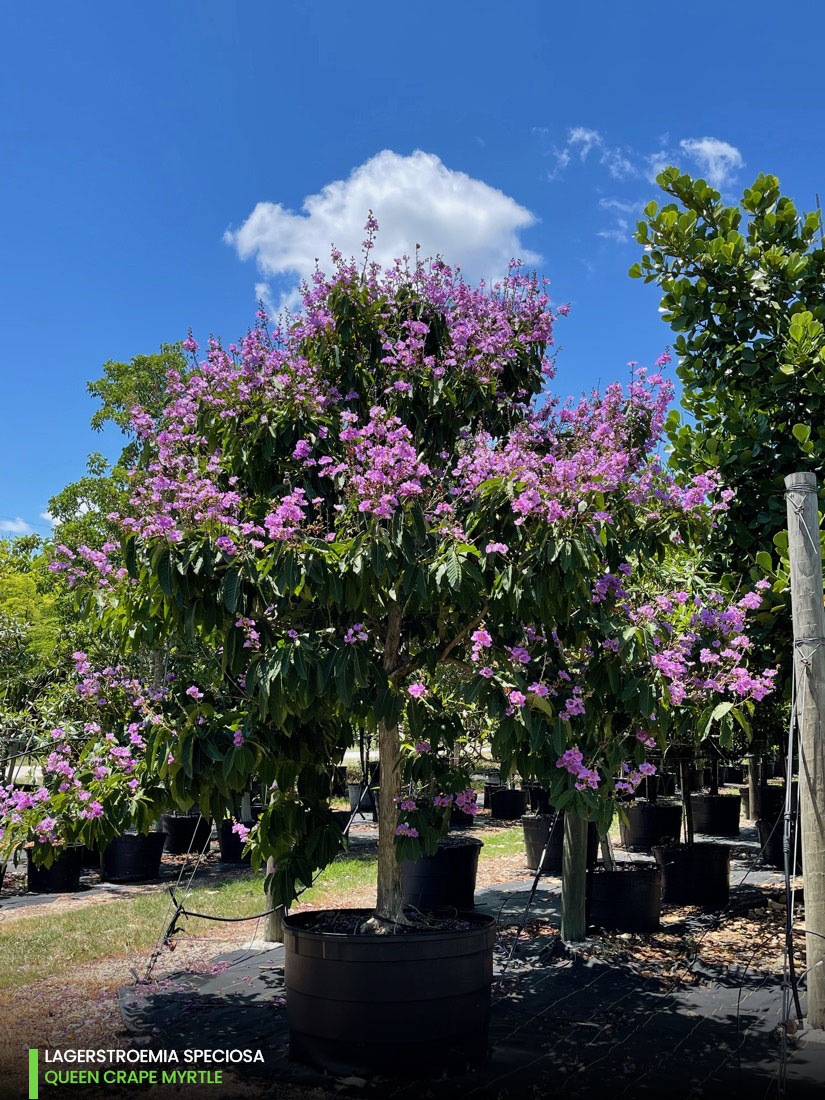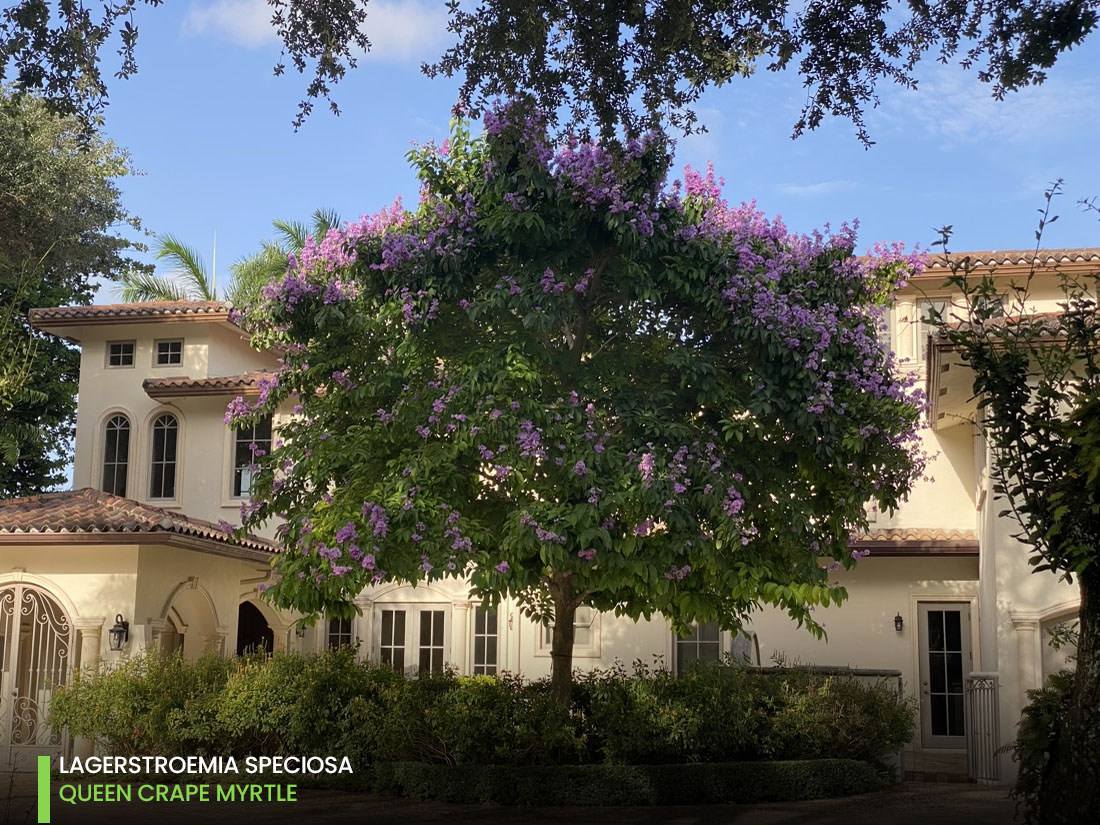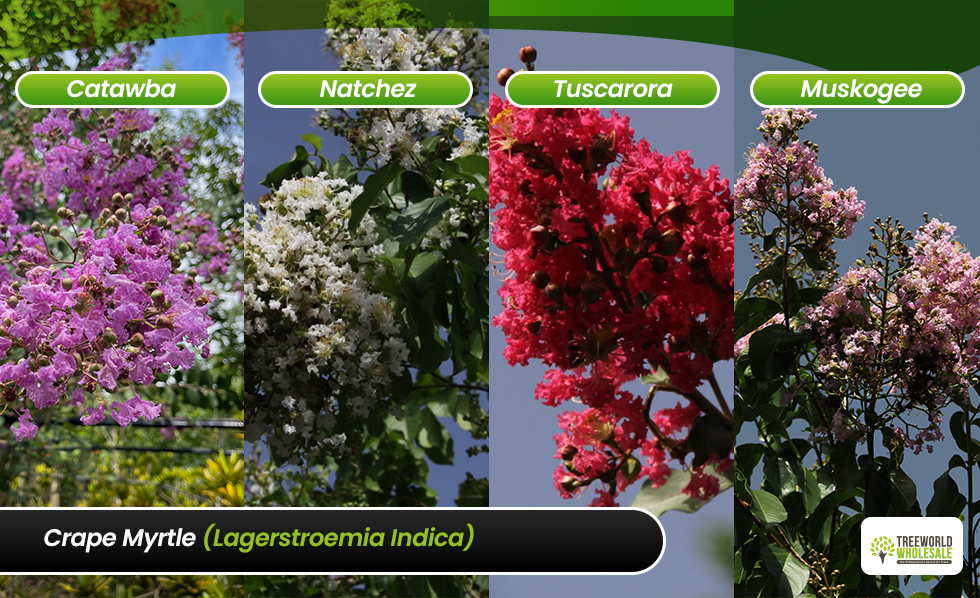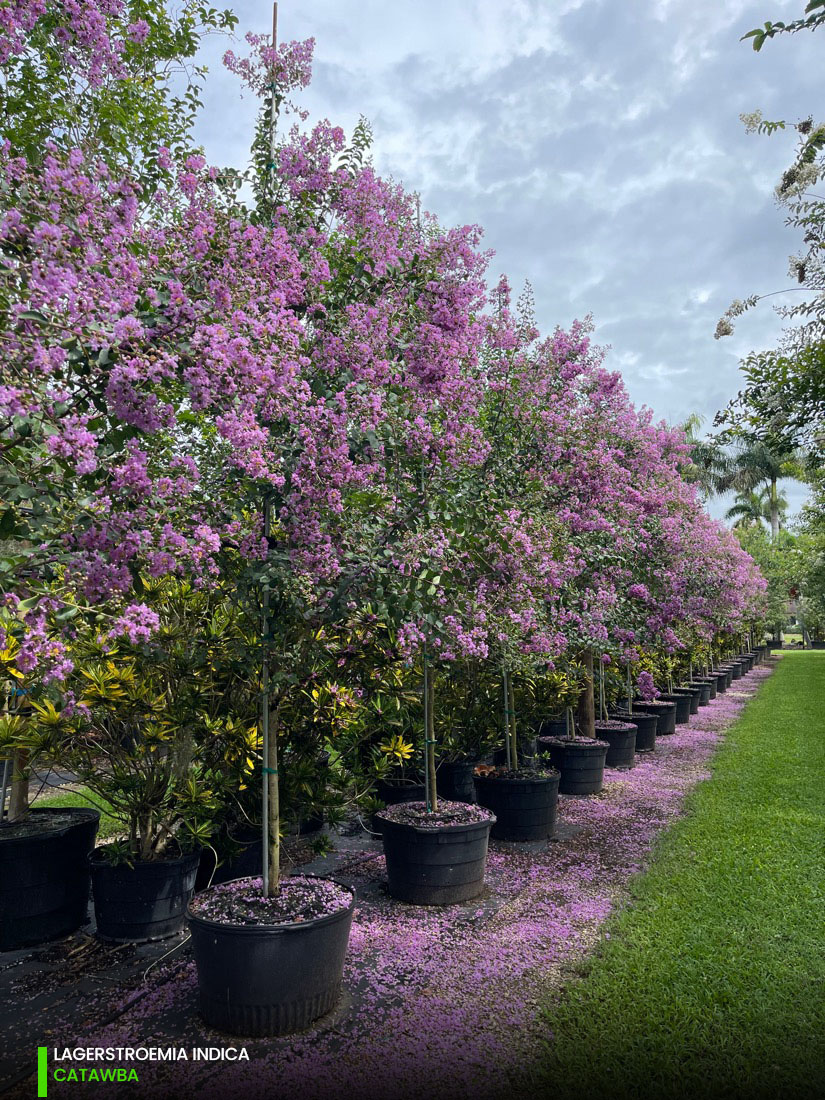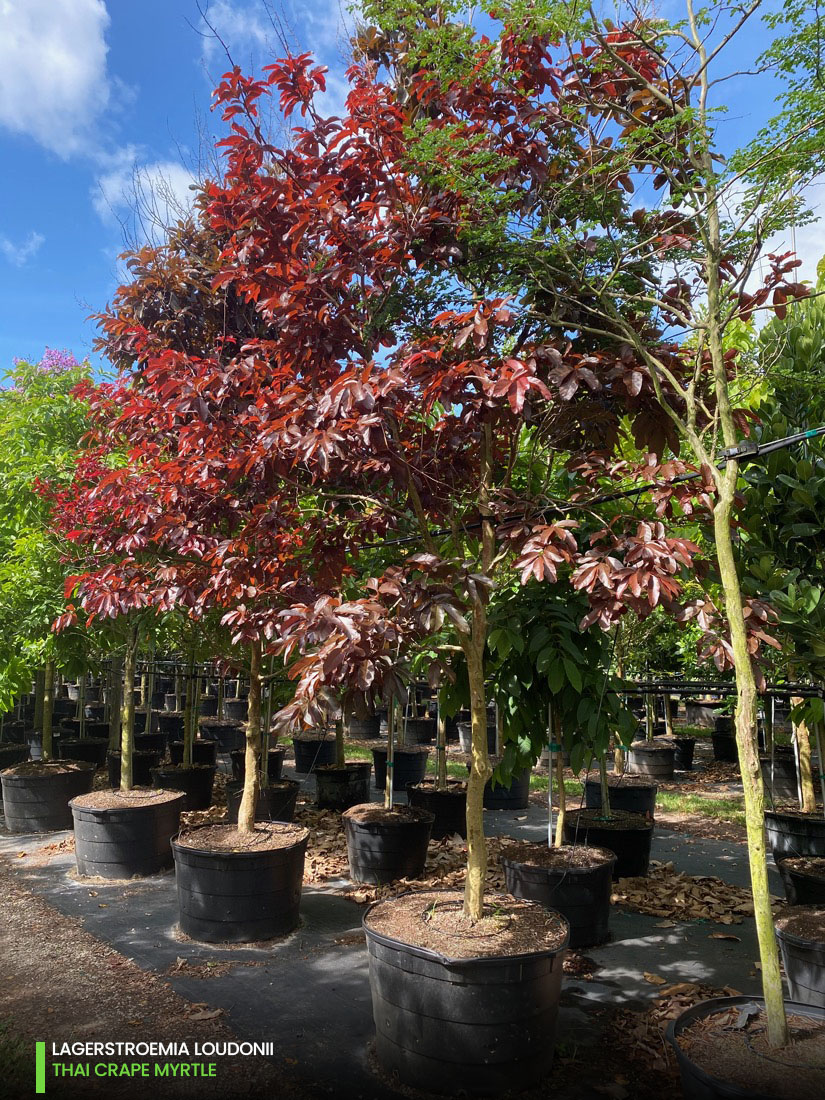With the complete natural ability to convey our attention to its alluring traits, the Crape Myrtles (Lagerstroemia Indica) and especially the Queen Crape Myrtle (Lagerstroemia Speciosa); have earned their place in the streets and landscape projects of South Florida and the Caribbean.
Marking the pace of time as this tree evolves year-round; thanks to its deciduous nature. First blooms begin to peek at the branch ends just in time to announce the end of spring and the beginning of summer. Almost like in Shakespeare’s Midsummer Night’s Dream the object of love and beauty becomes the object of our affection.
Crape Myrtle Origin and Genus
At TreeWorld we grow: Queen Crape Myrtle (Lagerstroemia Speciosa), and Lagerstroemia Indica (Muskogee, Tuscarora, Natchez, and Loudonii.) All members of the Lagerstroemia genus that has around 50 species, native to the Indian subcontinent (southeast Asia, northern Australia, and other parts of Oceania).
Therefore, over the next paragraphs, we will try to describe types of Crape Myrtle trees and what has made the Lagerstroemia so great. Earning not only a special place in south Florida as it is also recognized as one of the most distinguished ornamental trees worldwide. Starting off with the Queen Crape Myrtle.
Crape Myrtle Tree Types
Queen Crape Myrtle (Lagerstroemia Speciosa)
We start the types of Crape Myrtle trees with the Queen Crape Myrtle. And, without haste and with the delicacy that the word commands. We must recognize why the Lagerstroemia Speciosa has been crowned the Queen. And there is no doubt, as the long simple oblong leaves, arranged in an opposite manner, cover the droopy branches shaping a round crown.
Featuring its most alluring trait. The queen’s flowers are borne in large, erect terminal clusters from late April to June. Delicately filling up the branch’s tips with open crepe-like texture 3-inch-wide showy blooms of a graceful pastel palette. From the most sublime lavender color to an exquisite pink. Uncovering the yellow stamens that add light and contrast to this delicacy.
Furthermore, the Queen Crape Myrtle also has an attractive light grey to brown color bark of fissured texture. That peels off at regular intervals of thin flakes. Adding texture to the landscape and enhancing the beauty of the Lagerstroemia Speciosa.
Crape Myrtle (Lagerstroemia Indica)
Further on, not far from the ‘Queen’ is the Lagerstroemia Indica, best known as the Crape Myrtle. Which biggest difference from the ‘Queen’ is the size and the multi-trunk nature of the Lagerstroemia Indica.
That is to say, that the Lagerstroemia Indica grows to an average height of 10 – 30 feet and a spread of 15 – 25 feet. Either as a tree or as a shrub they make a great addition. Starting with the notable bark, which features a variety of colors. Ranging from grey to cinnamon, and soft pink. And of course, their sensational blooms. As they appear in clusters, forming panicles of the famous crinkled petals!
Catawba, Muskogee, Natchez, and Tuscarora
At TreeWorld we have 4 specimens of the Lagerstroemia Indica. The Catawba, Muskogee, Natchez, and Tuscarora. And an interesting fact about them is that back in 1962 The National Arboretum of Washington, D.C. developed new varieties (hybrids). All are named after Native American tribes, hence their common names.
Catawba Crape Myrtle
With an average height of 8 and 10 feet, it features gorgeous rich purple color blooms.
Muskogee Crape Myrtle
Muskogee Crape Myrtle reaches around 20 to 30 feet it displays the most endearing lilac blooms.
Natchez Crape Myrtle
Likewise, reaching up to 30 feet Natchez Crape Myrtle showcases stunning crème-like white flowers, that add an elegant touch next to the notable cinnamon-brown bark.
Tuscarora Crape Myrtle
With an average height of 20 feet, this vigorous Tuscarora Crape Myrtle tree displays some of the most alluring coral pink blooms.
Lagerstroemia Loudonii
And last on our list is the Thai Crape Myrtle (Lagerstroemia Loudonii) which is native to Burma and Thailand.
Furthermore, this exotic Crape Myrtle is cataloged to be of small to medium size, measuring around 10 – 20 ft. That stands out from the crowd thanks to its beautiful red, oval-shaped, glossy foliage.
Crape Myrtle Landscaping Ideas
In conclusion, we can agree that crape-myrtles are incredible trees. And they have multiple applications to embellish the South Florida landscape. Being summer-flowering trees, they play an important role in the yard or garden.
For instance, the Queen Crape Myrtle (Lagerstroemia Speciosa) makes a great accent tree or focal point in any landscape project. And Lagerstroemia Indica, with a wide color palette, can create different color schemes.
TreeWorld Availability
Finally, If you have an upcoming project the crape myrtle is a great tree to consider not only, is it beautiful but it’s easy to prune, and maintain, and loves the Florida sun. If you have any doubt about which one to choose or want to check our availability, please contact us!


